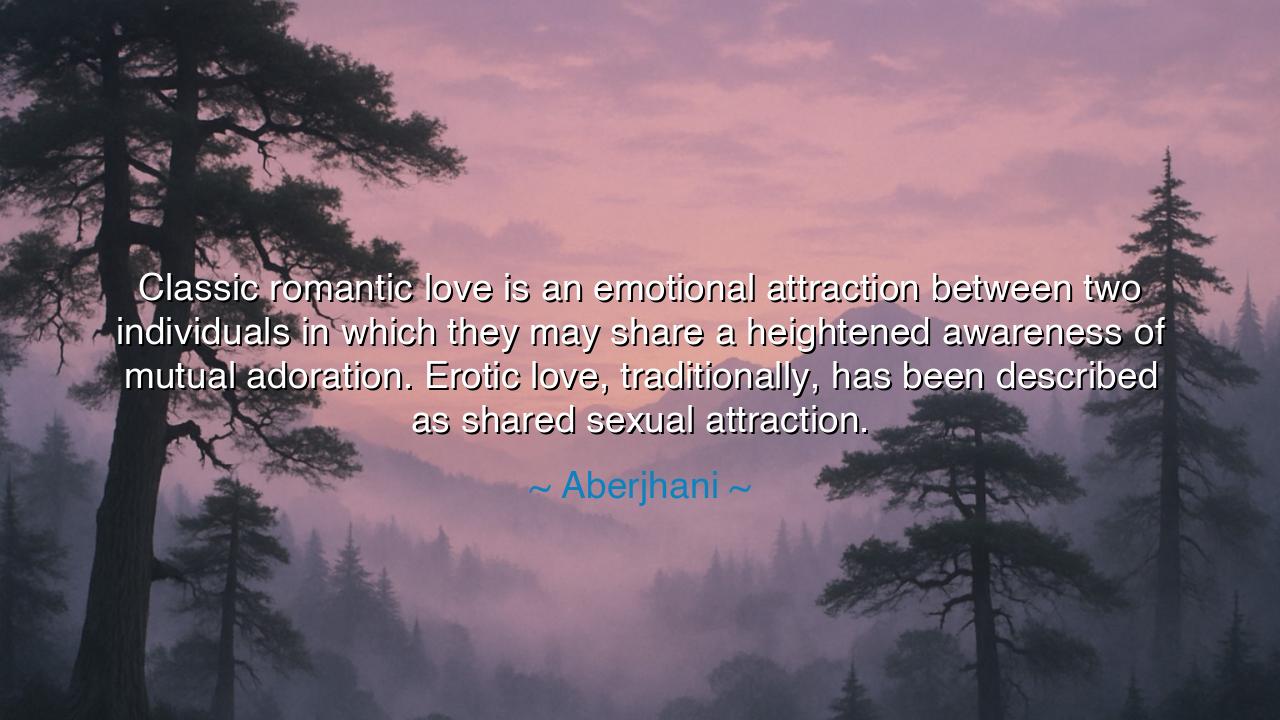
Classic romantic love is an emotional attraction between two
Classic romantic love is an emotional attraction between two individuals in which they may share a heightened awareness of mutual adoration. Erotic love, traditionally, has been described as shared sexual attraction.






"Classic romantic love is an emotional attraction between two individuals in which they may share a heightened awareness of mutual adoration. Erotic love, traditionally, has been described as shared sexual attraction." These words by Aberjhani distinguish between two powerful forces that have shaped human experience for millennia: romantic love and erotic love. Romantic love is an emotional bond, a connection between souls that transcends mere physical attraction. It is the feeling that exists when two individuals share a deep, often ineffable understanding and admiration for one another. In contrast, erotic love is rooted in physical attraction and desire—a bond that celebrates the raw, passionate, and intimate aspects of human connection.
In the ancient world, romantic love was often seen as the highest form of union, not simply between two individuals, but between the human and the divine. The myth of Orpheus and Eurydice, for example, is a timeless tale of romantic love that extends beyond life and death. Orpheus’ love for Eurydice was not based on mere physical attraction, but on an emotional connection that led him to descend into the Underworld itself to reclaim her. His journey was not about desire in the physical sense, but about the deep emotional bond that transcended earthly limitations. In this sense, romantic love as described by Aberjhani mirrors this ancient ideal—two individuals who share a heightened awareness of one another, where the love they feel reaches beyond the self to something greater, a soulful connection.
On the other hand, erotic love has always been an essential part of the human experience, but it has often been seen as more earthbound—a manifestation of the body's desire for intimacy and pleasure. The Greek myths are filled with tales of gods and mortals engaged in passionate encounters, often driven by physical longing. Consider the story of Zeus and Leda, whose affair resulted in the birth of Helen of Troy. Their union was marked by erotic desire, an attraction of bodies that produced one of the most famous figures in history. However, even in stories of erotic love, there is often an underlying emotional component. The tension between these two forces—romantic love and erotic love—has shaped countless human relationships and is often seen as a central theme in literature, philosophy, and art.
The distinction between romantic and erotic love, as Aberjhani describes it, is important because it reflects the balance that exists within human connection. Romantic love is the emotional glue that binds people, while erotic love fuels the physical expression of that connection. Consider the great poets of antiquity, such as Pablo Neruda, who wrote of both kinds of love with passion and depth. Neruda’s poetry often explored the intense emotional intimacy between lovers, as well as the physicality of love’s desire. He understood that love is multifaceted, and that the interplay between the emotional and the physical creates a bond that is uniquely human. His works express a profound awareness that both romantic and erotic aspects of love are essential to the whole of human connection.
In the medieval world, courtly love was another example of romantic love that emphasized the emotional aspects of affection over physical attraction. Tristan and Isolde is one of the most famous stories of courtly love, in which the emotional connection between the two lovers is celebrated more than their physical desire. Their love, though forbidden and tragic, is portrayed as a pure bond between two souls, reflecting the ancient ideal of romantic love that Aberjhani speaks of—an adulation that transcends the body and touches something sacred. However, even in courtly love, desire would sometimes emerge in the form of erotic tension, showing that both romantic and erotic love are often intertwined.
The lesson from Aberjhani’s quote is not only about the distinction between romantic and erotic love, but about how both forms of love are necessary in the human experience. Romantic love provides the foundation for a lasting connection, one that is emotionally rich and enduring, while erotic love is a celebration of the body's desires and the intimacy that two people can share. Both aspects of love feed into each other, and the greatest relationships are those in which both are present in a balanced and harmonious way. True intimacy, whether in love or in any deep connection, cannot exist in one realm alone.
In our own lives, we must learn to honor both the emotional and physical aspects of love. We must recognize that while romantic love can lift us to the heavens, it is the erotic connection that grounds us in the physical world, reminding us of our humanity. Let us strive to create relationships where both aspects are nourished, where we give not only our hearts but also our bodies, in moments of intimacy and desire. For it is in this intertwining of emotions and passion that the fullest expressions of love are realized, transcending the self and creating a bond that is timeless.






AAdministratorAdministrator
Welcome, honored guests. Please leave a comment, we will respond soon